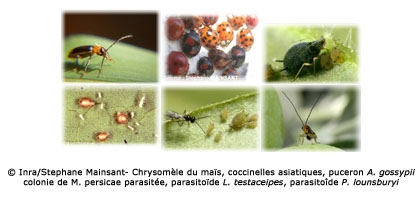The team studies the conditions for the installation and the evolution of introduced populations of insects. Our biological models are invasive pests and species used in biological control. Our research on introductions, subsequent demographic and geographic expansions, and the associated evolutive phenomena, is based on ecology and evolutionary biology. We combine behavioural ecology, population genetics and population dynamics.
Recent Publications
- Lesieur, V., Lombaert, E., Guillemaud, T., Courtial, B., Strong, W., Roques, A., and Auger-Rozenberg, M.-A. (2018). The rapid spread of Leptoglossus occidentalis in Europe: a bridgehead invasion. J Pest Sci 1–12. DOI: 10.1007/s10340-018-0993-x
- Lombaert, E., Guillemaud, T., and Deleury, E. (2018). Biases of STRUCTURE software when exploring introduction routes of invasive species. Heredity 120, 485–499. DOI: 10.1038/s41437-017-0042-1
- Morel‐Journel, T., Hautier, M., Vercken, E., and Mailleret, L. (2018). Clustered or scattered? The impact of habitat quality clustering on establishment and early spread. Ecography. DOI: 10.1111/ecog.03397.
- Zaviezo, T., Retamal, R., Urvois, T., Fauvergue, X., Blin, A., and Malausa, T. (2018). Effects of inbreeding on a gregarious parasitoid wasp with complementary sex determination. Evolutionary Applications 11, 243–253. DOI: 10.1111/eva.12537
Recent results
Invasion routes of the leafminer, Tuta absoluta,
The Lepidopteran pest of tomato, Tuta absoluta, is native to South America and is invasive in the Mediterranean basin. Its routes of invasion were investigated. The genetic variability of samples collected in South America, Europe, Africa and Middle East was analyzed using microsatellite markers to infer precisely the source of the invasive populations and to test the hypothesis of a single versus multiple introductions into the old continents. We used an Approximate Bayesian Analysis (ABC) which provided strong evidence that the origin of the invading populations is unique and is close to or is in Chile, and probably in Central Chile near the town of Talca in the district of Maule.
The highs and lows of dispersal: how connectivity and initial population size jointly shape establishment dynamics in discrete landscapes
Identifying the main factors driving introduced populations to establishment is a major challenge of invasion biology. Due to their small initial size, introduced populations are most vulnerable to extinction because of demographic stochasticity or Allee effects. While an increase in initial population size is known to increase establishment success, much remains to be understood regarding its interplay with connectivity in spatially structured environments. In order to better understand how demographic mechanisms interact at such spatial scale, we developed a stochastic model of population dynamics in discrete space to investigate the effect of connectivity and initial population size on establishment. The predictions derived from the model were then tested using experimental introductions of an insect parasitoid (Trichogramma chilonis) in spatially structured laboratory microcosms. Both theoretical and experimental results demonstrated that the connectivity of the introduction site had 1) a deleterious effect in the first generation when the introduced population was small and 2) a beneficial impact brought about by metapopulation effects in the subsequent generations. Interestingly, populations displayed a weakly pushed invasion pattern promoting early establishment, which was mainly underpinned by dispersal stochasticity and the discrete nature of the landscape. These results shed light on the critical influence of landscape connectivity on establishment dynamics.
Sterile males in a parasitoid wasp with complementary sex determination: from fitness costs to population extinction
Single-locus complementary sex determination (sl-CSD), which occurs in some insects of the order Hymenoptera, imposes a heavy genetic load that can drive small populations to extinction. The core process in these species is the development of individuals homozygous at the sex-determining locus into unfit diploid males. The risk of extinction of populations with sl-CSD is theoretically much higher if diploid males are viable and capable of mating but sterile, because diploid males then decrease the reproductive output of both their parents and the females with which they mate. We measured essential morphological, life-history and behavioral traits of diploid males of the parasitoid wasp Venturia canescens (Hymenoptera: Ichneumonidae), to improve predictions of population dynamics in this species. Diploid males resembled their haploid counterparts in most respects, but their mating success was nevertheless lower than that of normal, haploid males. Furthermore, although diploid males transferred viable sperm during copulation, they sired no daughters: the females with which they mated produced only sons, like virgin females. We developed a simulation model to bridge the gap between individual behavior and population genetics and dynamics. For two alternative hypotheses concerning the fertilization success of diploid sperm, we demonstrate that the mating success of diploid males is a crucial determinant of the probability of extinction.
Development of methods for population analyses of venome variability in parasitoids
Understanding the forces that shape eco-evolutionary patterns often requires linking phenotypes to genotypes, allowing characterization of these patterns at the molecular level. DNA-based markers are less informative in this aim compared to markers associated with gene expression and, more specifically, with protein quantities. The characterization of eco-evolutionary patterns also usually requires the analysis of large sample sizes to accurately estimate interindividual variability. However, the methods used to characterize and compare protein samples are generally expensive and time-consuming, which constrains the size of the produced data sets to few individuals. We developed a method that estimates the interindividual variability of protein quantities based on a global, semi-automatic analysis of 1D electrophoretic profiles, opening the way to rapid analysis and comparison of hundreds of individuals. The main original features of the method are the in silico normalization of sample protein quantities using pictures of electrophoresis gels at different staining levels, as well as a new method of analysis of electrophoretic profiles based on a median profile. We demonstrated that this method can accurately discriminate between species and between populations, based on interindividual variation in venom protein profiles from three endoparasitoid wasps of two different genera (Psyttalia concolor, Psyttalia lounsburyi and Leptopilina boulardi).
Biological models studied
- Invasive pest insects: the corn root worm Diabrotica virgifera, Pseudococcid mealybugs, the Asiatic ladybird Harmonia axyridis, the tomato leaf miner Tuta absoluta ;
- Insects introduced as biological control agents: The parasitoid Mastrus ridens, mealybug parasitoids and trichogramma.
Scientific originality of the team
We study invasion biology with various perspectives: behavioural ecology, population dynamics and population genetics. Another original characteristic of the team is its experimental approach to study invasive processes. We use biological control operations as an experimental model and we hope to use our results on invasion biology to improve biological control operations
Current Subject
Which demographic, genetic and environmental factors determine the success or failure of accidental invasions (introduction of a pest) or planned introductions (introduction and acclimatisation of a biological control agent)?
Scientific partnerships and support for programmes
- National collaborations: CBGP Montpellier, Bio3P Rennes, INA-PG, University Lyon 1, Plant Breeding and Genetics Division (GAFL) Avignon, CIRAD Montpellier, etc ;
- International collaborations: CSIRO Australia, EBCL/USDA Montpellier, University of Iowa, Colorado State University, University of Palermo, etc.
The research theme of the team receives support from various federative programmes and through calls for tender (Plant Health and Environment Division of INRA, PACA Regional Authority, Biodiversity Research Fundation (FRB) and Research National Agency (ANR)).








